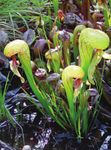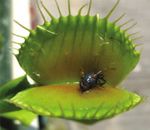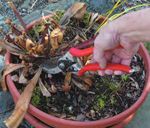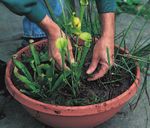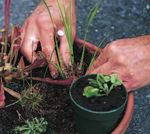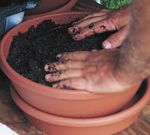Growing Carnivorous Plants in containers - American Horticultural Society
←
→
Page content transcription
If your browser does not render page correctly, please read the page content below
Carnivorous
growing
Plants in containers BY CAROLE OTTESEN
Making a container bog garden
with carnivorous plants is an
easy and entertaining project.
I
F Y O U T H I N K of bogs as slimy,
snakey, and squishy underfoot and the
words “bog garden” strike you as an
oxymoron, read on! You may become one
of a growing number of gardeners who
will discard images of pre-historic human
sacrifice and man-eating Little-Shop-of-
Horrors plants to discover the pleasures of
bog gardening. If so, you’ll learn that bogs
are unique ecosystems that are easily
Left: Hybrid pitcher plants bloom at the le ft: ca role otte s e n. right: courte s y of s te fa no Zucchina li
Atlanta Botanical Garden. Above: A Venus
flytrap exhibits the remains of a digested fly.
maintained, happily containerized, and,
best of all, home to a range of fascinating-
ly beautiful, carnivorous plants.
Loosely interpreted, the word “bog”
refers to any ground that is water-logged.
But the kind of bog that supports carniv-
orous plants is both water logged and nu-
trient poor. Usually highly acidic, it is
composed of accumulated organic mate-
rial—most often, sphagnum peat.
18 the American GardenerHOW TO CREATE YOUR OWN BOG GARDEN PLANTER
Containers make it easy to satisfy the
needs of carnivorous plants, which are:
an acidic, low-nutrient growing medi-
um, mineral-free water, consistent
moisture, and full sun. The growing
medium is a blend of fine sphagnum
peat and children’s playground sand
that has been washed. To supply the
plants with mineral-free water, you
must collect rainwater or use bottled
drinking water labeled sodium-free;
simply boiling tap water will not remove
minerals.
One of the attractions of growing 1. PREPARING. Combine equal amounts 2. PLANTING. Arrange the potted plants
carnivorous plants is their low mainte- of sphagnum peat and sand in a buck- on the surface of the filled container
nance. For several years, I’ve grown et with water until you get a mudlike until you get a design you like. A tip:
them in containers left outside year mixture. You can also mix in perlite or Set taller plants either in the middle
round in an exposed area of my USDA pine needles for texture. Then fill the or off to one side. Then make a hole in
Zone 7, AHS Zone 7 garden in Mary- container with the mixture—firming it the growing medium below each plant
land. I’ve lost some sundews and down to remove air pockets—to within and insert the plants, tamping down
Venus flytraps to smothering by sphag- two inches of its rim. Set the container gently around the rootballs.
num moss but not to winter cold. in a water-filled tray.
—C.O.
WHAT YOU WILL NEED
■ Assorted carnivorous plants
■ Container with a drainage hole and a
deep dish or tray that holds water in
which the container can be set to keep
the growing medium wet
■ Sphagnum peat
■ Sand (well washed)
■ Perlite or pine needles (optional) 3. FINISHING. Carefully arrange wet 4. MAINTAINING. Water regularly to keep
■ Bucket for mixing growing medium pieces of live sheet sphagnum moss medium wet. Remove the occasional
■ Water (mineral free) on top of the growing medium around weed and overgrown sphagnum moss as
■ Sheets of live sphagnum moss each plant. This makes the container needed. Plants go dormant in the winter.
more attractive and also helps prevent In spring, cut off dead parts with prun-
the medium from drying. ing shears before growth resumes.
The kinds of plants that live in this nu- necessitating a hot and steamy greenhouse Being able to watch these ornamental
trient-poor habitat descended from prim- in which to grow them,” writes nursery- natives dine has great entertainment value
itive pre-historic ancestors and have had man Peter D’Amato of California Carni- as well as a practical aspect: Plants that
eons to develop cunning mechanisms for vores in The Savage Garden, which feed themselves don’t need fertilizer. In
deriving nourishment by means other received an AHS Book Award in 1999. “In fact, fertilizer, good soil, and mineral-en-
than from the soil. In other words, they truth…most carnivorous plants grow in riched water are all too rich a diet for most
carole ottesen (4)
trap their own food. temperate climates…and the North carnivorous plants. What they need is
“Most folks assume that such weird American continent has the widest variety pure water, a sterile, acidic growing medi-
vegetation certainly must come from of ornamental carnivorous plant genera in um, and a place in the sun. These simple
some far-off, exotic, and tropical country, the world.” needs render them ideally suited for life in
January / February 2 0 1 1 19a container where they can be combined
with other plants or grown alone. Either
way, their culture is so easy, a child can
take care of them.
Actually, young children, being the
primitive beings they are, love to tend
them. Their ghoulish curiosity has not
been dulled by years of concentrated civi-
lization. They will watch with fascination
as pitcher plants lure unsuspecting insects
to be imprisoned and digested. Forget
grandma’s gallstones, the fingernail that
fell off when the car door slammed on it,
or the desiccated anole you finally found
under the dishwasher. Containerized bog
gardens with their ravishing, ravenous
plants are the ultimate show-and-tell.
PLANTS FOR THE BOG GARDEN
Finding plants well suited to a bog gar-
den environment is actually quite easy,
especially since many carnivorous plants Sitting in a deep, water-filled tray, this terracotta planter of blooming red pitcher plants
are native to North America. Just be sure makes an attractive and unusual centerpiece for a patio table.
you purchase your plants from a rep-
utable source (see “Sources,” opposite Over the last decade or so, a number of veins. It bears cranberry-red flowers that
page). Many bog plants are illegally har- outstanding pitcher plants (Sarracenia stay showy from spring until fall.
vested from the wild and certain species spp.) with gorgeous leaves and spectacu- Pitcher plants are eating machines.
are endangered. Buying propagated lar flowers have been selected and propa- Every aspect of their anatomy is adapted
plants is not only easy on the environ- gated by tissue culture. One of these, to lure, trap, and digest food. Nectar
ment and likelier to yield healthy plants, released by the Atlanta Botanical Garden glands and bright red veins attract prey to
it will enrich your bog with extraordi- (ABG), is Sarracenia leucophylla ‘Tarnok,’ the plant’s lip—a structure that doubles as
narily ornamental hybrids and selections. a white-topped pitcher with maroon-red a handy landing pad. From here, the in-
top : ca role otte s e n. b ottom (2): courte s y of noa h e lha rdt
Left: A closeup view of a sundew’s tentaclelike
leaves shows the exuded drops of a sticky
substance that serve to ensnare insects.
Above: The aptly-named cobra orchid is native
to California and Oregon.
20 the American GardenerSources
California Carnivores, Sebastopol,
CA. (707) 824-0433.
www.californiacarnivores.com.
Carnivorous Plant Nursery, Derwood,
MD. (301) 519-7505.
www.carnivorousplantnursery.com.
Sarracenia Northwest, Eagle Creek,
OR. (503) 630-7522.
http://cobraplant.com.
Resources
Carnivorous Plants of the United
States and Canada by Donald E.
Schnell, Timber Press, Portland,
Oregon, 2002.
Growing Carnivorous Plants
by Barry Rice. Timber Press,
Portland, OR, 2006.
International Carnivorous Plant
Society, www.carnivorousplants.org.
The Savage Garden by Peter D’Amato,
Ten Speed Press, Berkeley, Califor-
nia, 1998.
sects—often flesh flies (Sarcophagidae)
and ant species—are lured down inside
the pitcher—almost always a one-way
trip. Downward-pointing hairs accelerate
progress down, but impede any escape up-
ward. Farther along the tubular leaf is the Endangered green pitcher plant (Sarracenia oreophila) grows wild in a Georgia wetland.
slippery slope. On its sticky edge, the un-
fortunate insects struggle, then plummet around it and digestive enzymes begin rare, protected, or at-risk plants. And
to their deaths in the drowning pool at the their grisly work. three pitcher plant species as well as the
base of the pitcher. Cobra orchid (Darlingtonia californi- Venus flytrap have been listed as “feder-
Venus flytrap (Dionaea muscipula) is ca) resembles a cobra head with a hood ally endangered.”
well-named. Its eyelid-shaped leaves form and “fangs”—a fishtail-shaped appendage Ironically, while digging up a single
two halves of an efficient trap. When lured below the hood. Native to California and Venus flytrap in North Carolina could
by nectar, an insect lands on one of the coastal Oregon, cobra orchids are denizens land you in jail with fines up to $50,000,
leaves and the eye shuts. Large hairs, like of running water in areas underlain by ser- razing an entire bog to make way for a
eyelashes, act as bars to keep it imprisoned pentine rock—habitat requirements that housing development doesn’t seem to
while enzymes in the leaf glands digest it. are difficult to duplicate in a container gar- raise an eyebrow. “In the United States,
While Venus flytrap is endangered in the den. Insect prey are attracted by a sweet over 95 percent of the original carnivo-
wild, plants have been produced by tissue nectar fragrance and may fly or crawl to rous plant habitats along the southeast-
culture. A beautiful red cultivar, ‘Akai Ryu’ the rolled edge of the plant’s mouth from ern coastal plain are gone,” says
courte sy of u.s. fish and wildlife s e rv ice
(sometimes listed as ‘Red Dragon’) was in- which they topple into the depth of the D’Amato, adding, “the devastation and
troduced by ABG in 1997. pitcher’s hollow leaf. Downward-pointing disappearance of carnivorous plant habi-
Sundews (Drosera spp.) have long hairs impede escape. tats throughout the world is currently be-
tentaclelike leaves that are covered with a yond alarming.”
sticky substance that glitters like dew in RARE AND ENDANGERED PLANTS
the sunlight. It also acts as a powerful Carnivorous species turn up with discour- Carole Ottesen is a contributing writer for
glue, so when an insect lands on the aging regularity on rare and endangered The American Gardener. This is an adapt-
leaves it is stuck fast. As the insect strug- lists. Over 30 species and sub-species of ed version of an article she wrote for the
gles to escape, hairs on the tentacles close Sarracenia appear on many state lists of magazine in July/August 2003.
January / February 2 0 1 1 21You can also read




